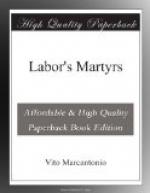Introduction
By William Z. Foster
On November 11, 1937, it is just fifty years since Albert R. Parsons, August Spies, Adolph Fischer, George Engel and Louis Lingg, leaders of the great eight-hour day national strike of 1886, were executed in Chicago on the framed-up charge of having organized the Haymarket bomb explosion that caused the death of a number of policemen. These early martyrs to labor’s cause were legally lynched because of their loyal and intelligent struggle for and with the working class. Their murder was encompassed by the same capitalist forces which, in our day, we have seen sacrifice Tom Mooney, Sacco and Vanzetti, the Scottsboro boys, McNamara, and a host of other champions of the oppressed.
Parsons and his comrades were revolutionary trade unionists, they were Anarcho-Syndicalists rather than Anarchists. In the early ’eighties, when they developed their great mass following, the mass of the workers were just learning to organize to resist the fierce exploitation of a ruthless capitalism. The great eight-hour strike movement led by the “Chicago Anarchists” gave an enormous impulse to trade union organization everywhere and it was for this that the employing interests had them hanged. When, for example, the older Chicago unions nowadays go out on parade on Labor Day, banner after banner bears the historic dale of 1886. Indeed, the A. F. of L. was practically established nationally at that time. Although the A. F. of L. had been founded in 1881, it never got a real hold among the masses until the big strike movement of 1886, which established the unions in man pew trades and industries and brought about the reorganization and renaming of the A. F. of L.
In many respects 1937 bears a kinship to 1886. Once again labor is making a vast surge forward, but on a much higher political level. In 1886, and the years following, the best that the working class could do in the way of organization was to produce the craft union movement, which, notwithstanding all its failings, was an advance in liveability at least, over the amorphous and confused Knights of Labor. But now, the working class, grown stronger, more experienced and more ideologically developed, has given birth to the C.I.O. movement, with its industrial unionism, trade union democracy, organized political action and generally advanced conception of the workers’ struggle. The militant trade union movement of today, heading towards a broad People’s Front, is the direct lineal descendant of the great strike movement of the 1886 Chicago martyrs.




